1. What are some different types of depth information?
2. What is binocular disparity, and how this information interpreted to produce stereopsis?
3. How do stereograms (including SIRDSs) produce stereopsis?
4. What is the correspondence problem?
5. What is size constancy? What environmental information allows this mechanism to work?
6. How does information about depth contribute to illusions, such as the moon illusion?
7. What is human factors and ergonomics? What perceptual factors contribute to grade crossing accidents?
Types of depth perception:
• ________ distance judgment: “egocentric” localization (you ![]() → object)
→ object)
• ________ distance judgment: requires object-relative localization (object ![]() → object)
→ object)
_________ Depth Cues
• can be extracted from a 2-D picture
• _________: if object A covers part of object B, then A is seen as closer than B
• shading & shadows: indicates which surfaces are facing the light source and which are not
• ___________ perspective: greater absolute distance makes objects appear fuzzier, bluer
Leonardo da Vinci suggested application in painting (“Thus if one is to be five times as distant, make it five times bluer.” da Vinci, 1888, ¶295)
• relative size: same size object farther away produces smaller visual angle
• ________ size: knowledge of object’s actual size influences perception of its distance
• linear perspective: apparent convergence of receding parallel lines at a vanishing point
Brunelleschi (c. 1413): “Brunelleschi’s peepshow”
- painted the Baptistry over its reflection in a ______
- drilled peephole through it, and faced painting toward the Baptistry
- observers looked through the hole toward the Baptistry
- Brunelleschi held a mirror facing the painting--the real Baptistry would be replaced by a _______ copy
- key were the vanishing points, which determine the _______
- horizon also passes through the oblique vanishing points which define the two-point perspective
e.g., one-point perspective:
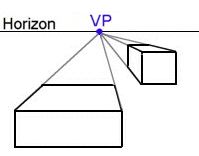
e.g., two-point perspective:
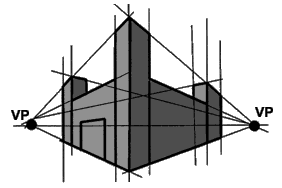
- established the importance of linear perspective in art
Alberti (1435): Alberti’s window/grid (perspective grid)
|
- scene viewed through a window divided into cells - artist copies each cell onto paper - used to overcome top-down bias, which led to more realistic, representational art |
• relative ______: below the horizon, higher objects appear farther away; above the horizon, lower objects appear farther
• _______ gradient: texture elements appear smaller and more densely arranged as they get farther away
- higher-order depth cue: made up of linear perspective + relative size
Motion-Based Depth Cues
• motion ________: as observer moves perpendicular to object (side-to-side), nearby objects appear to move past more rapidly than faraway objects
• ________: background object is occluded by foreground object moving in front of it
• _________: background object is uncovered by foreground object moving out of the way
• _____________: crystalline lens changes shape to focus on objects
- feedback from ciliary muscles provides information on lens curvature, and therefore distance
• ___________: rotation of eyes inward to cause image to fall on the fovea
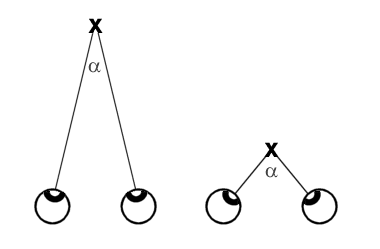
- smaller convergence angle = farther object; larger angle = closer
• oculomotor depth cues only work for distances less than ~2 m
Interaction of depth cues:
- depth cues rarely used alone; mostly used in conjunction with others
- accuracy in estimating distance is an ________ relation between depth cues
- also, perception of depth is stronger with more cues
• __________: perception of depth based on retinal disparity alone
- retinal (or _________) disparity: retinal images of an object fall on disparate points on each eye’s retina
- ________: imaginary surface passing through fixation point
- if a distal stimulus lies on the horopter, then the proximal stimulus will fall on corresponding points on each retina (no _________):
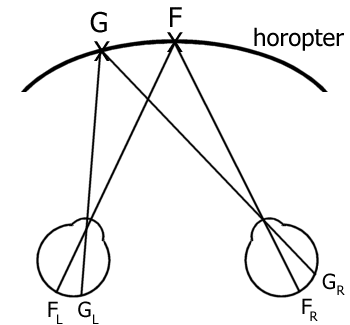

- if a distal stimulus is not on the horopter, then the proximal stimulus produces _________:
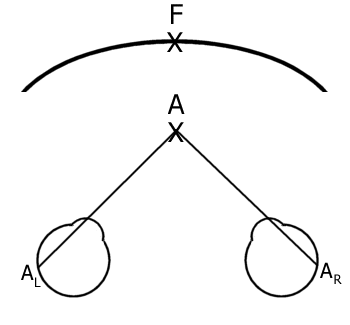
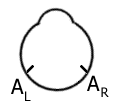
- the distance between points on each retina is called the ______ (or angle) of disparity
- the farther from the horopter, the greater the disparity
Random-dot ___________ (Julesz, 1964)
- each eye sees the same pattern of random dots--with one exception
- central region in each pattern is shifted over; this creates retinal disparity
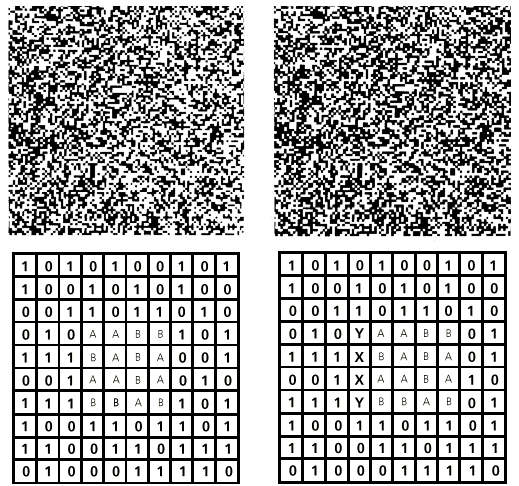
- shifted region is perceived as floating above the background
Single-Image Random-Dot Stereograms (SIRDSs, or autostereograms: Tyler, 1983; Tyler & Clarke, 1990):
e.g., Magic Eye® pictures
- retinal disparity in autostereograms is produced in ________ way from random-dot stereograms
- usually, two slightly different images are directed onto the same part of each retina
- in SIRDSs, a ______ image is observed so that it falls on two different parts of each retina
How to see autostereogram:
1. have a small angle of convergence (e.g., look at a wall or distant object)
2. look at autostereogram, but don’t change convergence; you should see two overlapping images
3. change accommodation to bring images into focus, keeping convergence constant
4. change convergence until repeating parts of the pattern line up horizontally
You should see a floating _____
How is it determined which dots (or visual features) in the left eye match with which dots (or visual features) in the right eye, to fuse the two images into one percept?
- several solutions have been proposed
- for example, Marr & Poggio (1976) developed a complex neural-network solution that depends on a number of factors including __________: matches are made only between elements that are similar
e.g., a black dot in the left eye can only match a black dot in the right eye
- however, no widely accepted solution has yet been created
Holway & Boring (1941):
- task: adjust size of comparison circle to match that of various sized test circles, placed at different distances
- visual angle of all test circles is 1° (same retinal size or visual angle)
Part 1: Normal viewing
• if test circle was large (and far), observers chose _____ comparisons, too
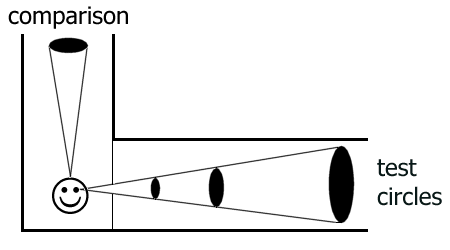
Part 2: Depth cues __________
• observers looked at test circles with one eye through a ________
• all stimuli had the same visual angle, so the size of the comparison matched the visual angle of the test circle--not the ____ of the test circle
Bruner & Goodman (1947):
- 10-year-old children estimated the size of coins, using an adjustable disc of light
- coins were consistently judged to be ______ than identically sized cardboard discs
- this suggests that the monetary _____ of coins caused overestimation of their size
- further, children from poorer backgrounds perceived the coins to be even bigger than did children from richer backgrounds
- ___-____ processing affects size perception
• size-distance invariance: as distance from a given object increases, retinal image becomes smaller--yet we do not perceive the object as getting smaller
• distance taken into account when perceiving size: ____-________ scaling
• distance & depth cues (pictorial, accommodation, convergence, disparity) must be available, or errors will occur
• _________ are often caused by misapplied size constancy (generally exist on paper; are rare in the real world)
Müller-Lyer Illusion (1889):
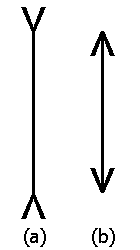 |
Richard Gregory (1966, 1968, 1997): - illusion is weaker in ________ - and in people living in dome-shaped huts - “___________ world” hypothesis: (a) like inside corner of a room, (b) like outside edge of a building - depth cues indicate (a) is relatively far away, (b) is relatively close - due to size constancy, (a) appears ______, (b) appears _______ |
- but what about (Parker & Newbigging, 1963):
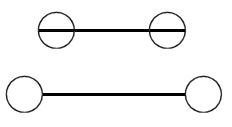
(there are no room or building angles)
• horizon moon seems to be much larger than zenith (overhead) moon
• but moon’s _______ size (0.52°), and actual ________ (392,000 km) are essentially constant
• misjudgment of moon’s size is an illusion, resulting from a misperception of distance
• if an object perceived to be (or actually) farther away has the same visual angle as an object perceived to be (or actually) nearer, the farther object will appear larger


Apparent-distance theory:
- objects on the horizon, viewed across the filled space of the terrain, should appear to be farther away
- objects at the zenith, seen through the empty space of the sky, should appear to be closer
Holway & Boring (1940):
- observers viewed projections of the moon and reported that the horizon moon looked closer than the zenith moon--contradicting apparent-distance theory
- when questioned, observers explained this was because the horizon moon appeared larger
- proposed the eye _________ hypothesis: moving eyes upwards makes objects appear smaller
- had observers try to compare size of the moon to a projection:
• when eyes looked up at zenith moon: moon seemed small
• when lying down, eyes looked straight at zenith moon: moon seemed larger
- thus, position of the eyes affects size perception and subsequent decisions about distance--but ___?
Kaufman & Rock (1962):
- couldn’t replicate eye elevation results; it was difficult for observers to match the sizes of two faraway objects
- does misperception of size cause error in distance judgment--or vice-versa?
- alternative:
1) ________ Law (1881):
• perceived size of an object having a constant visual angle is proportional to the (perceived) distance of the object


2) Claudius Ptolemy (c.130):
• planets were objects that moved on sets of transparent heavenly spheres
• “vault of the _______” is flattened
• the moon seems to travel along a flat sky
• horizon appears farther away
- result:
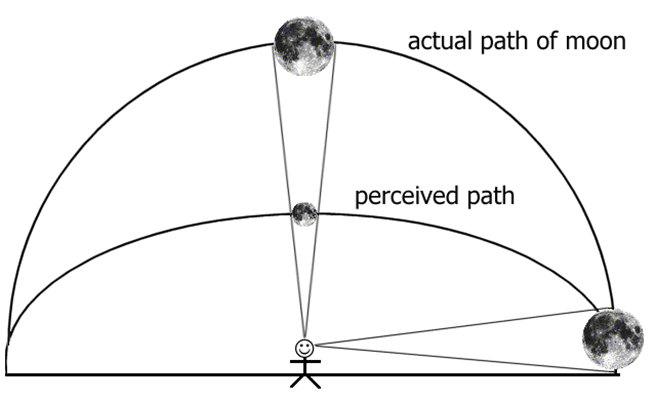
• zenith moon appears ______ than horizon moon
• due to size constancy, its apparent size is thus _______
- may be due to ______: are closer at zenith than at the horizon, creating misperception of the sky being a surface
Human factors and ergonomics: An area of psychology relating to the ______ and engineering of equipment and systems that people use--intentionally taking into account information about how people perceive, think, and behave.
Goals are safe, comfortable, and effective human use.
Grade Crossing Accidents and Human Factors Engineering:
- in the United States in 2023, there were 2,192 collisions at rail crossings that resulted in 248 fatalities and 765 injuries (U.S. Department of Transportation, 2024)
- in Canada in 2024, there were 167 rail-crossing collisions that resulted in 12 fatalities and 24 serious injuries (Transportation Safety Board of Canada, 2025)
Contributing sensory and perceptual factors (Herschel Leibowitz, 1985):
• speed-____ illusion (size-arrival effect)
- voluntary pursuit eye movements are used when tracking a moving object
- the amount of effort this requires depends on the velocity of the object and the extent of its contour (size)
- tracking a larger object--like a train--requires less effort, and therefore is perceived to be moving more slowly
• illusion of (______) perspective
- converging parallel contours from trees, telephone poles, and train tracks contribute to distance cues
- increases perceived distance of the train, contributing to an overestimation of the safe time interval
• deceptive ________ of collisions
- as distance to train decreases, the visual angle of the train increases (“looming”)
- the rate of increase is not linear, but is a hyperbolic (exponential) function
- that is, as distance decreases, the visual angle increases at an accelerated rate, leading to an overestimation of the safe time interval to cross the tracks
Possible solutions:
• basic visual processing cannot be changed
• separating highways and rail tracks by overpasses or bridges is _________
• Operation Lifesaver public awareness campaign
- promotes rail safety to school groups, driver education classes, and professional drivers
- since it began in 1972, train-motor vehicle collisions have decreased by 83%
• more ________ on redesigning rail crossings and warnings
e.g., special markings or lights could potentially enhance the perceived speed of large objects like locomotives